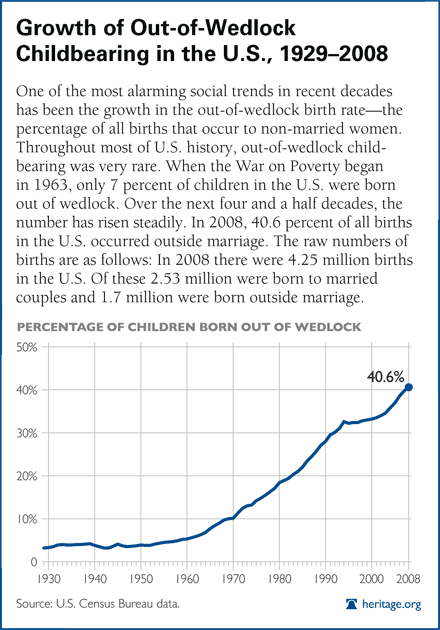THE ISSUE:
The institution of marriage draws mothers and fathers together in the smallest of communities, reinforcing bonds with their children and cementing ties across generations. Marriage is the necessary foundation of the family and therefore essential for societal existence and well-being. The erosion of marriage thus affects communities both small and large, reducing human happiness, weakening civil society, producing negative social consequences, and imposing vast new costs on taxpayers. Federal tax, health, and welfare policy has often undervalued the benefits of forming married families and keeping them together.
- Marriage Decline Is Due to Many Factors. Over the past 40 years, out-of-wedlock births have gone from 10 percent of all births to 40.6 percent in 2008. No-fault divorce, changes in social attitudes and religiosity, family-destructive welfare policies, and radical political movements have all contributed to the incremental weakening of marriage.
- The Social Cost of Marriage Decline Is Enormous. Children raised in married households do better on every significant measurement of personal well-being and attainment. They perform better in school, commit fewer crimes, engage in fewer risky behaviors, experience less poverty, and have fewer marital problems as adults. The annual cost of means-tested welfare alone for single parents is $300 billion.
- Divorce Rates Are Stabilizing but Still High. The U.S. divorce rate fell in 2009 for the first time in years, but the weakening economy puts more long-term stress on married households. Lower-income families and their children are hit harder by higher rates of marital breakdown and have fewer resources to cope with the effects of father absence.

- Block the Obama Restoration of the Marriage Penalty in the Tax Code. The tax cuts that expire at the end of 2010 include marriage penalty relief that has been in place for a decade. The Joint Tax Committee estimates that 35 million couples will pay an average of $595 more in taxes in 2011 alone if marriage penalty relief is not extended.
- Repeal New Marriage Penalties Included in Obamacare. The Patient Protection and Affordable Care Act provides tax credits for the purchase of health insurance, but the configuration of these credits imposes new marriage penalties that could exceed $10,000 a year for certain couples. These penalties provide another strong reason for the repeal of Obamacare and the enactment of real reform.
- End the Welfare Marriage Penalty. Current means-tested welfare programs penalize low-income recipients who choose to marry. These anti-marriage penalties should be reduced or eliminated.
- Fund an Advertising Campaign to Promote the Benefits of Marriage. Programs like the “healthy marriage initiative” in the Department of Health and Human Services stressed the long-term benefits of marriage for child outcomes and encouraged low-income couples at risk of government dependency to marry and stay married. Funding for such programs should be increased and not diluted with separate job training and similar initiatives. Messaging about marriage, including public service advertising, should provide information on the importance of marriage to individuals in communities who have a high risk of having children out of wedlock, with emphasis on the benefits to children of a married mother and father.
------------------
SUPPORTING DOCUMENTS:
- Marriage Penalty - How to Fix the Marriage Penalty in the Tax Code
- Marriage Penalty - The 2001 and 2003 Bush Tax Cuts: Economic Effects and Permanent Extension
- Obamacare Marriage Penalty - Obamacare: The Impact on the Family
- Obamacare Marriage Penalty - The New Federal Wedding Tax: How Obamacare Would Dramatically Penalize Marriage
- Welfare Marriage Penalty - Confronting the Unsustainable Growth of Welfare Entitlements: Principles of Reform and Next Steps
- Advertise Benefits of Marriage - Marriage: America's Greatest Weapon Against Child Poverty
- Advertise Benefits of Marriage - The Poverty Solution: Marriage or Bust
- Advertise Benefits of Marriage - Marriage, Parentage, and the Constitution of the Family
